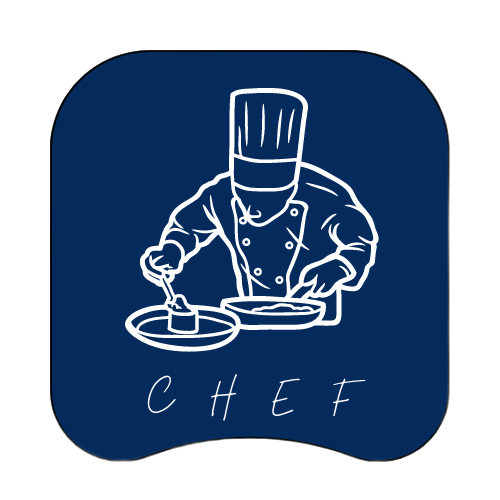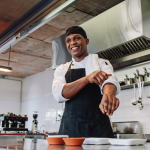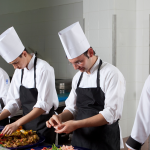1) Choose your base
While traditionally you’ll find cheese boards served on wooden boards, you’re certainly not limited to this aesthetic. You can use cheese board bases made out of slate (this gives a beautiful colour contrast to the cheeses), marble, and other types of stone. There are also a wide variety of wooden options besides your classic cutting board, such as bamboo and personalised options.
2) Pick your favourite cheeses
Start your cheese board with your favourite cheeses and then find cheeses with complementary or opposing flavours. For example, you may start with some strong-flavoured cheeses such as mature Cheddar and Stilton. And then add more mild-flavoured cheeses, such as Brie and Swiss.
You may then finish the board with Feta or another goat cheese to give another dimension to the board. A selection like this not only gives you a variety of flavours but a variety of textures, too.
3) Build out your cheese board
Next, go back to our list of foods to serve with your cheese board above and choose what other foods and flavours you want to serve with your cheeses.
If you’re choosing a lot of milder cheeses, consider adding more salty flavours, and add more sweet if you’re opting for stronger, tangier cheeses.
4) Arrange your cheese board
Now you’ve got all the elements of your board ready to go, you can head out to the shop to get what you need.
But how do you arrange it all?
You can put together a stunning board in about 10 minutes.
– First, make sure your base is clean and ready to go. You can use a chopping board for this. But as we touched on earlier, slate and stone also give a beautiful finish.
–Next, decide what’s going in the centre of the board; you may choose a large round cheese, a bunch of grapes, or a few slices of bread are all good choices. You don’t have to put it directly in the middle of the board if you’d rather your arrangement look a little more natural.
–Next, place another focus point food in each “corner” around your centre point food (imagine quarters around the centre point if you’re using a round board). Again, this could be a small jar of jam, a bowl of olives or gherkins, or another one of your chosen cheeses.
–Around these, arrange the rest of your cheeses, meats, and anything else you’re serving. Rolling or folding cold meats is a beautiful way to add plenty to your board without resorting to piling up your food, but don’t be afraid to do a little piling as long as it looks intentional and not haphazard.
–Finally, add a few sprigs of fresh herbs or small bunches of grapes in between your foods to tie everything together. A cheese platter is best made 30-60 minutes before you serve it. But it can easily wait 3-4 hours, too, provided it’s covered and refrigerated. Just make sure you don’t add anything like bread until you’re ready to serve.
Want to skip ahead?
- What is a cheese board?
- How many cheeses
- A selection of cheeses
- What else to serve on the board
- Building a board
- How to arrange
- The crowd pleaser
Complete Cheese Board Guide
Thinking about putting together an impressive cheese board for your next gathering? A cheese board never fails to please and is incredibly easy to put together while looking like you’ve gone above and beyond to serve it.
While doing research for your cheese board can be time-intensive. This complete guide will help you cut to the good stuff so you can put together a delicious cheese board in almost no time at all. Let’s get started.
What is a cheese board?
A cheese board (sometimes called a cheese platter) is typically a wooden cutting board covered in a variety of cheeses, served after dinner or as a side at a large meal.
These boards often also serve cold meats, wafer biscuits, and fruit, such as grapes.
How many cheeses should be on a cheese platter?
Unless you’re putting together a very small cheese board (as you may for a light picnic for two), you should aim for around 5 different cheeses.
These cheeses should represent a variety of textures and flavours, such as soft, firm, mild, and mature.
What should I serve on a cheese board
Here are some ideas for what you can serve on your cheese board:
A Selection Of World Cheeses
- Appenzeller – a hard Swiss cheese that has a mild to strong nutty flavour
- Asiago – a medium to hard Italian cheese with a nutty and creamy flavour, a little like Parmesan
- Brie – a mild soft French cheese with a creamy texture
- Camembert – another mild soft French cheese, much like Brie, but often has a slightly stronger taste
- Cheddar – a popular medium to hard cheese with a mild to strong, tangy taste, depending on its maturity
- Danish Blue – a medium to soft cheese with flecks of blue and a strong, sharp taste
- Feta – a crumbly, Greek white cheese made from goat and sheep’s milk with a tangy, salty, taste that can be quite sharp
- Grana Padano – A hard cheese with a mild nutty flavour
- Gorgonzola – A blue cheese with plenty of marbling but a much milder flavour than other blue cheeses, making it a good choice for guests with a milder palette
- Gouda – A Dutch cheese with a creamy texture and a nutty yet sweet taste, a good choice for adults and children alike
- Neufchatel – A soft French cheese with a strong, salty and yeasty taste
- Maasdam – A mild yellow cheese with holes that offers a creamy, mild and often sweet taste
- Mozzarella – A classic soft cheese with a mild flavour when eaten uncooked, best served with some olive oil, balsamic vinegar, and fresh cherry tomatoes
- Parmesan – A popular hard cheese with a strong flavour and gritty texture, serve as small sticks or cubes
- Radamer – A Polish cheese with holes and a subtle flavour
- Roquefort – A traditional blue cheese with a creamy texture and strong, tangy taste
- Stilton – A British blue cheese with a rich, mellow flavour but a strong after taste
- Swiss – the classic mild, creamy cheese with plenty of holes, serve as slices
Other Foods To Serve With A Cheese Board
- Cheese biscuits – these are a must!
- Bread with some olive oil and/or balsamic vinegar for dipping
- Cold cuts of meat that are typically cured, uncured or smoked such as Prosciutto di Parma and salami
- Fruit such as grapes, strawberries, tomatoes, and dried apricots
- Jam ,honey and chutneys
- Nuts such as peanuts and cashews
- Marinated and pickled vegetables such as artichokes, olives, and gherkins
- Spices such as dried chilli flakes
What’s the difference between a charcuterie board and a cheese board?
A charcuterie board is a board where the focus is on meat instead of cheese.
While both charcuterie boards and cheese boards can contain the same things, it’s where the focus of the board lies that makes the difference.
The Cheese Board Crowd Pleaser
A cheese board is a crowd-pleaser at any event, whether you serve it as an appetiser before a dinner party, as a side at a buffet, or as a savoury alternative to dessert.
With our guide above, you can quickly plan and present your platter. Just try not to devour too much of it while you’re putting it together!



















